Knee pain is a common issue that can arise from various causes such as arthritis, injury, or overuse. Yoga can be an effective way to manage and alleviate knee pain by strengthening the muscles around the knee, improving flexibility, and promoting proper alignment. Here are 11 yoga poses that can help relieve knee pain:
Mountain Pose (Tadasana)
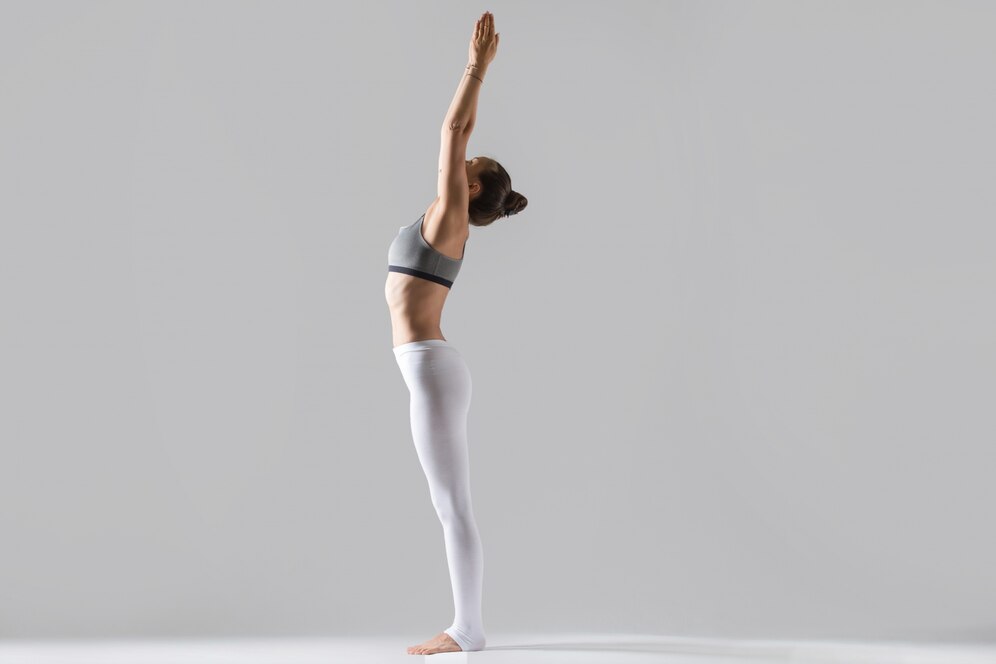
- Benefits: Improves posture, strengthens the legs, and promotes proper alignment.
- How to Do It: Stand with your feet hip-width apart, weight evenly distributed. Engage your thighs and lift your chest. Keep your shoulders relaxed and arms by your sides. Breathe deeply and hold for 30 seconds to 1 minute.
Chair Pose (Utkatasana)
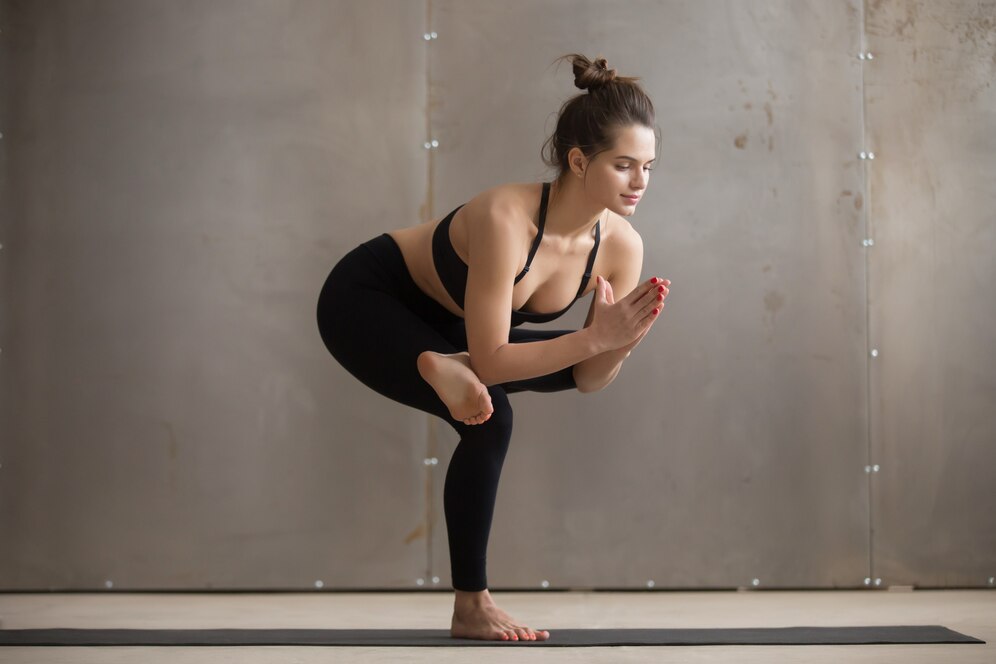
- Benefits: Strengthens the quadriceps, which support the knee joint, and improves balance.
- How to Do It: Stand with feet together. Bend your knees and lower your hips as if sitting in a chair. Keep your back straight and arms extended overhead. Hold for 20-30 seconds, then return to standing.
Warrior I (Virabhadrasana I)
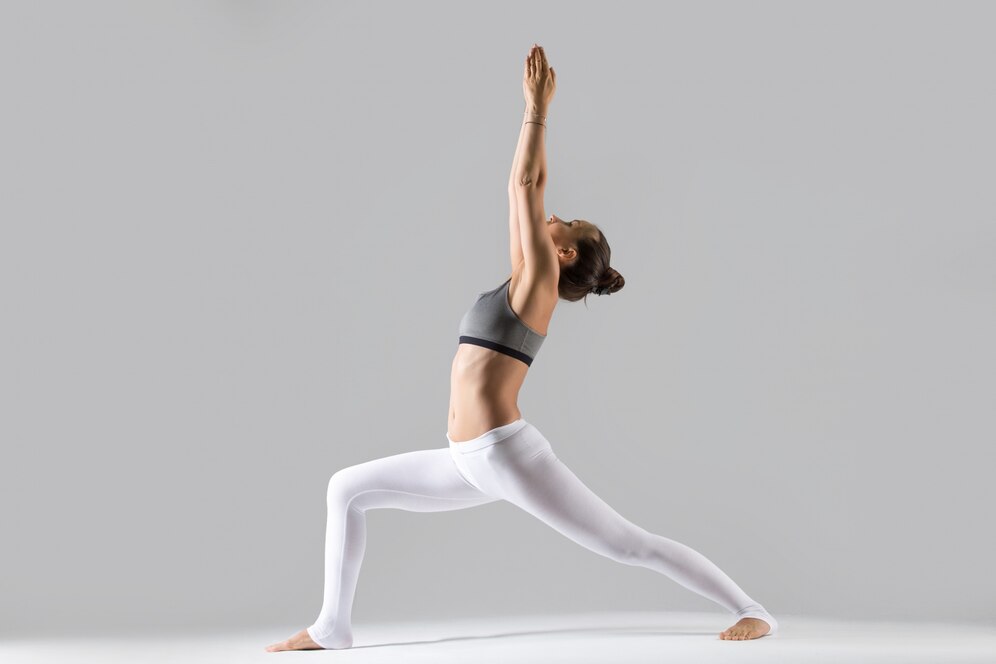
- Benefits: Strengthens the legs, hips, and core, and improves stability.
- How to Do It: Step one foot back and bend the front knee. Keep your back leg straight and feet hip-width apart. Raise your arms overhead and look forward. Hold for 30 seconds to 1 minute, then switch sides.
Warrior II (Virabhadrasana II)
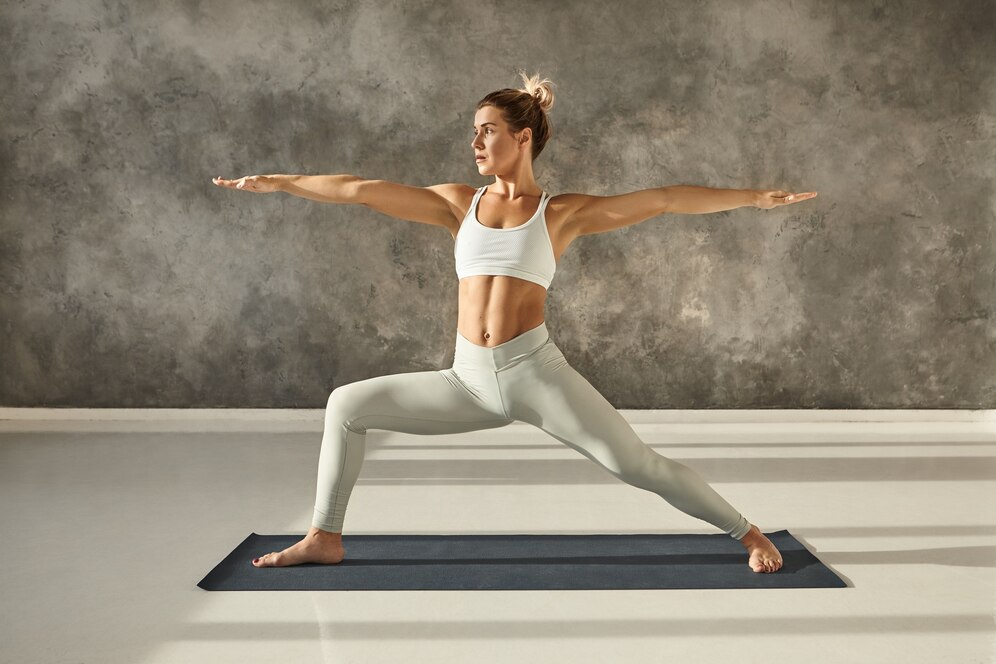
- Benefits: Strengthens the thighs and improves flexibility in the hips and knees.
- How to Do It: From Warrior I, open your hips and shoulders to face the side. Extend your arms parallel to the floor and gaze over your front hand. Hold for 30 seconds to 1 minute, then switch sides.
Tree Pose (Vrksasana)
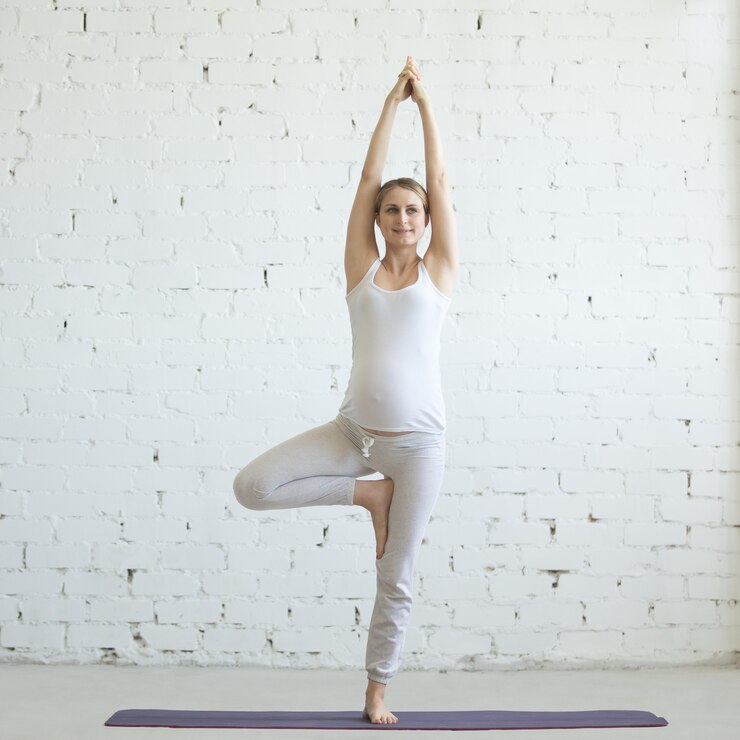
- Benefits: Enhances balance and strengthens the muscles around the knee.
- How to Do It: Stand on one leg and place the sole of your other foot on your inner thigh or calf (avoid the knee). Bring your hands to prayer position at your chest or extend them overhead. Hold for 20-30 seconds, then switch sides.
Bridge Pose (Setu Bandhasana)
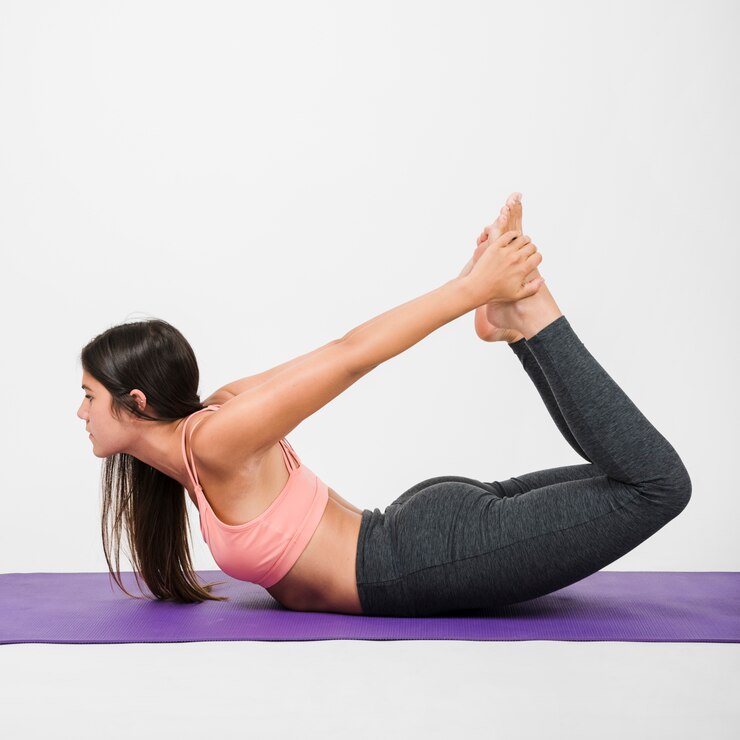
- Benefits: Strengthens the glutes, hamstrings, and lower back, which support the knee joint.
- How to Do It: Lie on your back with knees bent and feet hip-width apart. Lift your hips towards the ceiling while pressing your feet and arms into the floor. Hold for 20-30 seconds, then lower your hips.
Leg Raises (Supta Padangusthasana)
- Benefits: Stretches the hamstrings and strengthens the quadriceps, reducing strain on the knees.
- How to Do It: Lie on your back and extend one leg straight up towards the ceiling. Use a strap or towel around your foot for support. Hold for 20-30 seconds, then switch legs.
Downward-Facing Dog (Adho Mukha Svanasana)
- Benefits: Stretches and strengthens the entire body, including the legs and knees.
- How to Do It: Start on your hands and knees. Lift your hips towards the ceiling, straightening your legs and forming an inverted V shape. Press your heels towards the floor. Hold for 30 seconds to 1 minute.
Cat-Cow Pose (Marjaryasana-Bitilasana)
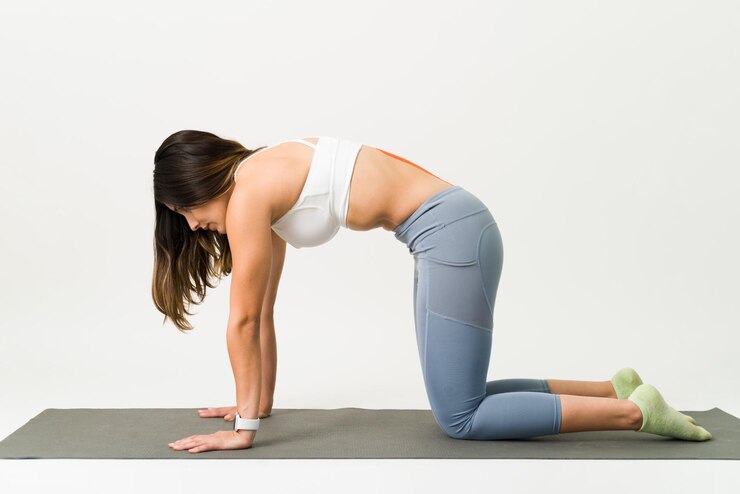
- Benefits: Increases flexibility in the spine and pelvis, reducing strain on the knees.
- How to Do It: Start on your hands and knees. Inhale as you arch your back (Cow Pose) and exhale as you round your spine (Cat Pose). Continue for 30 seconds to 1 minute.
Child’s Pose (Balasana)
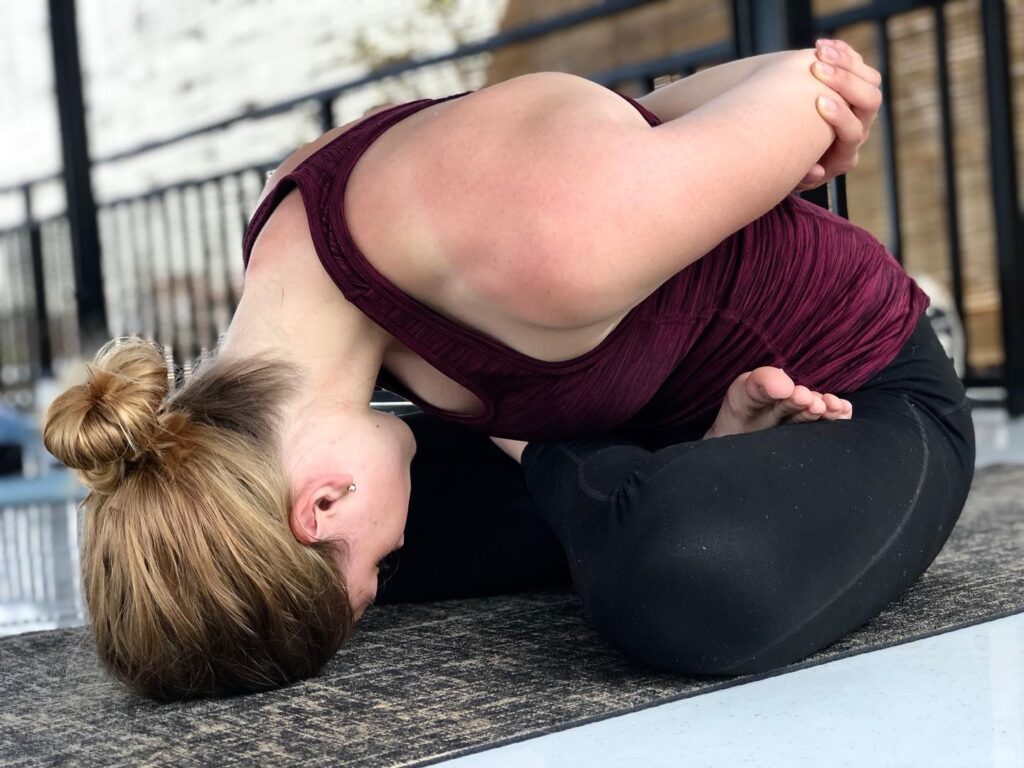
- Benefits: Gently stretches the knees, hips, and back, providing relief from knee pain.
- How to Do It: Kneel on the floor and sit back on your heels. Reach your arms forward on the floor and lower your forehead to the mat. Hold for 30 seconds to 1 minute.
Butterfly Pose (Baddha Konasana)
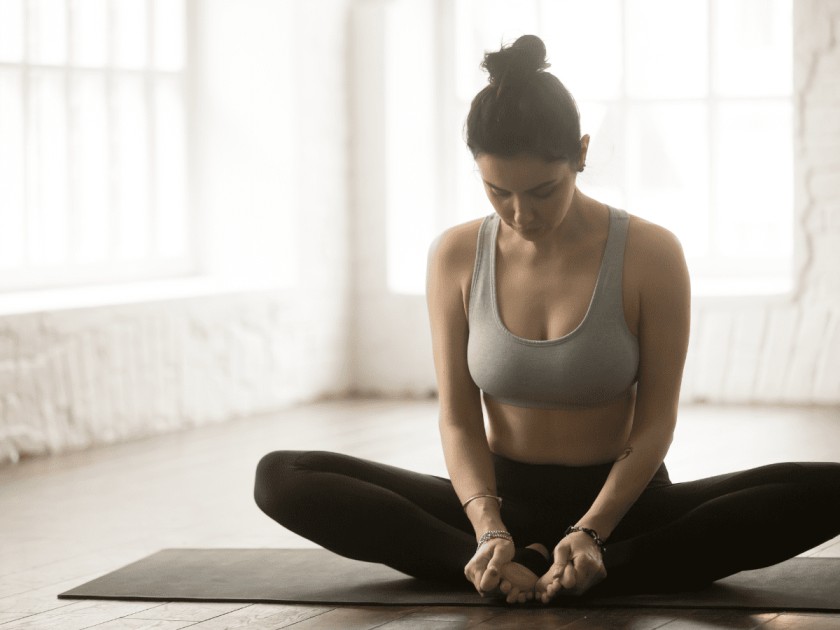
- Benefits: Opens the hips and stretches the inner thighs, which can relieve knee discomfort.
- How to Do It: Sit with your legs bent and the soles of your feet together. Gently press your knees towards the floor and lean forward slightly if comfortable. Hold for 30 seconds to 1 minute.
Tips for Practicing Yoga with Knee Pain
1. Consult a Healthcare Professional
- Importance: Before starting or continuing yoga with knee pain, consult a healthcare provider to determine the cause of your knee discomfort and get personalized recommendations.
- Action: Obtain a diagnosis and ensure there are no contraindications for practicing yoga.
2. Choose Low-Impact Poses
- Importance: Low-impact poses reduce strain on the knees and help avoid aggravating the pain.
- Examples: Opt for poses like Child’s Pose, Cat-Cow, and Bridge Pose, which are gentle on the knees.
3. Use Props for Support
- Importance: Props can provide stability, reduce strain, and modify poses to accommodate knee pain.
- Examples: Use yoga blocks for support in standing poses, blankets for cushioning in seated poses, and straps to assist with flexibility.
4. Modify Poses as Needed
- Importance: Adjusting poses can make them more accessible and comfortable for those with knee pain.
- Action: Modify poses to avoid deep bending or pressure on the knees. For instance, perform a supported Warrior II with a block under your hands.
5. Focus on Alignment
- Importance: Proper alignment prevents unnecessary stress on the knees and helps maintain joint health.
- Action: Pay attention to the alignment of your feet, hips, and knees in each pose. Ensure your knees track in line with your toes.
6. Strengthen Supporting Muscles
- Importance: Strengthening the muscles around the knees can provide better support and alleviate pain.
- Action: Incorporate exercises that strengthen the quadriceps, hamstrings, and calves into your yoga practice.
7. Avoid High-Impact or Deep Bending Poses
- Importance: High-impact or deep bending poses can exacerbate knee pain.
- Examples: Avoid poses like Deep Squats or intense lunges if they cause discomfort. Opt for gentler alternatives.
8. Incorporate Gentle Stretching
- Importance: Gentle stretching can improve flexibility and reduce tension around the knee joint.
- Examples: Include stretches like the Reclining Hand-to-Big-Toe Pose or Supine Figure-Four Pose.
9. Listen to Your Body
- Importance: Paying attention to your body’s signals helps prevent further injury and discomfort.
- Action: If a pose causes pain, back off or modify it. Respect your limits and avoid pushing through discomfort.
10. Practice Mindfulness and Breathing Techniques
- Importance: Mindfulness and proper breathing can help you manage pain and stay focused during your practice.
- Action: Incorporate deep breathing exercises and mindfulness techniques to promote relaxation and reduce pain perception.
11. Warm-Up and Cool Down
- Importance: Warming up prepares your muscles and joints for activity, while cooling down helps with recovery.
- Action: Begin with gentle warm-up exercises like Cat-Cow Pose and end with restorative poses like Legs-Up-The-Wall Pose.
12. Incorporate Restorative Yoga
- Importance: Restorative yoga helps to relax the body and mind while providing gentle support for knee pain.
- Examples: Use poses like Supported Bridge Pose or Supta Baddha Konasana with bolsters and blankets for added comfort.
13. Avoid Twisting or Hyperextending the Knee
- Importance: Twisting or hyperextending the knee can exacerbate pain and lead to injury.
- Action: Modify or avoid poses that involve excessive twisting or hyperextension of the knee joint.
14. Seek Guidance from a Qualified Instructor
- Importance: An experienced instructor can provide personalized modifications and ensure proper technique.
- Action: Work with a yoga teacher who has experience with knee pain and can guide you through appropriate modifications.
15. Practice Consistency
- Importance: Regular practice can help improve joint health and manage pain over time.
- Action: Incorporate yoga into your routine consistently, focusing on gentle, knee-friendly poses.
Practicing yoga with knee pain requires careful attention to avoid exacerbating the issue while still benefiting from the practice. By following these tips, you can create a safe and effective yoga practice that supports knee health and overall well-being. Remember to consult with healthcare professionals and listen to your body to ensure a positive and pain-free yoga experience.
FAQ on Yoga Poses for Knee Pain Relief
1. What are the best yoga poses for relieving knee pain?
Some of the best yoga poses for knee pain relief include:
- Mountain Pose (Tadasana): Improves alignment and strengthens legs.
- Chair Pose (Utkatasana): Strengthens the quadriceps, which support the knee.
- Bridge Pose (Setu Bandhasana): Strengthens the glutes and hamstrings, reducing knee strain.
- Child’s Pose (Balasana): Gently stretches and relaxes the knees.
- Leg Raises (Supta Padangusthasana): Stretches the hamstrings and reduces knee discomfort.
2. Can yoga worsen knee pain?
Yoga can potentially worsen knee pain if poses are performed incorrectly or if modifications are not used. It’s important to use proper alignment, avoid high-impact or deep bending poses, and listen to your body. Consulting with a healthcare professional or experienced yoga instructor can help ensure that you practice safely.
3. How can I modify yoga poses to accommodate knee pain?
Modifying yoga poses for knee pain involves:
- Using Props: Employ yoga blocks, blankets, or straps for support and stability.
- Adjusting Depth: Avoid deep bends or high-impact movements; use less intense variations.
- Choosing Alternatives: Opt for gentle poses that do not strain the knees, such as Child’s Pose instead of Deep Squats.
4. Is it safe to practice yoga with a recent knee injury?
If you have a recent knee injury, it’s crucial to consult with a healthcare provider before practicing yoga. They can provide guidance on what poses are safe and which should be avoided. It’s generally advisable to start with gentle, restorative poses and avoid any movements that cause pain.
5. How often should I practice yoga for knee pain relief?
Practicing yoga consistently, about 2-3 times per week, can help manage knee pain and improve overall joint health. However, the frequency should be adjusted based on your comfort level and the severity of your knee pain. Always listen to your body and avoid overexertion.
6. Are there specific yoga poses to avoid with knee pain?
Yes, poses that put excessive strain on the knees should be avoided or modified. These include:
- Deep Squats or Lunges: Can put significant pressure on the knees.
- Forward Bends: Intense forward folds can strain the knees if not done with proper alignment.
- Twisting Poses: Excessive twisting can exacerbate knee pain if not properly supported.
7. Can yoga help with chronic knee conditions like arthritis?
Yoga can be beneficial for chronic knee conditions such as arthritis by improving flexibility, strength, and alignment. Gentle, low-impact poses and proper modifications can help reduce pain and improve mobility. Always consult with a healthcare provider to tailor the practice to your specific condition.
8. What should I do if I experience pain during a yoga session?
If you experience pain during yoga, stop the pose immediately and assess your alignment and technique. Use props or modifications to make the pose more comfortable. If pain persists, consult with a healthcare provider or a qualified yoga instructor for personalized advice.
9. How can I strengthen the muscles around my knee through yoga?
Strengthening the muscles around the knee can be achieved through poses that target the quadriceps, hamstrings, and calves:
- Chair Pose (Utkatasana): Strengthens the quadriceps.
- Bridge Pose (Setu Bandhasana): Targets the glutes and hamstrings.
- Leg Raises (Supta Padangusthasana): Strengthens the hamstrings.
10. Can I use yoga as a long-term solution for managing knee pain?
Yes, incorporating yoga into your routine can be a long-term solution for managing knee pain. Regular practice, combined with proper modifications and attention to alignment, can help improve knee function and reduce pain over time. Always consult with a healthcare provider to ensure it complements your overall treatment plan.
11. Are there specific breathing techniques that can help with knee pain during yoga?
Yes, breathing techniques can aid in managing knee pain during yoga:
- Deep Breathing: Helps relax the body and reduce tension.
- Mindful Breathing: Focus on your breath to stay present and avoid pushing through pain.
- Abdominal Breathing: Promotes relaxation and helps manage discomfort.
By addressing these common questions, you can better understand how to safely and effectively use yoga for knee pain relief. Always remember to consult with professionals and listen to your body’s signals.

